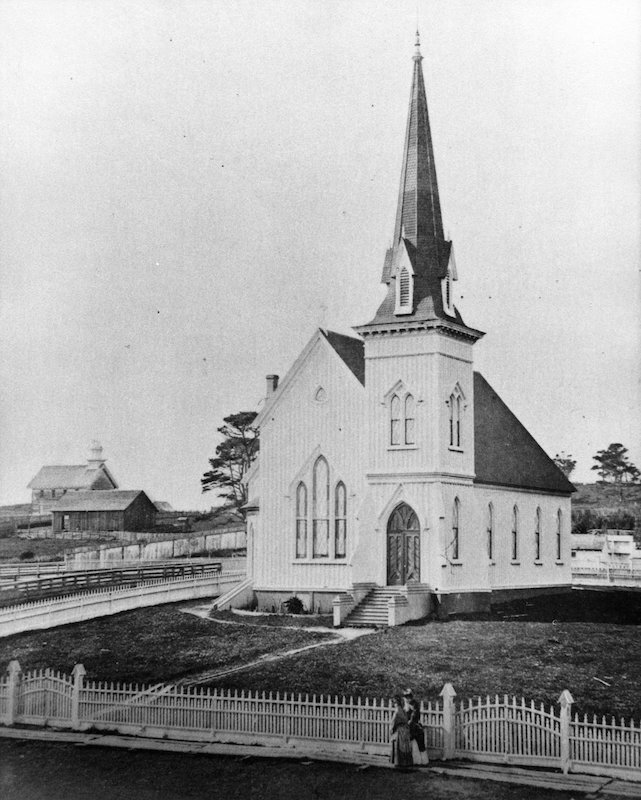
Mendocino Presbyterian Church, c. 1873 -1890, from the Kelley House Archives. (Gift of Donald Tucker)
This week, the Mendocino Presbyterian Church celebrates the 155th anniversary of its sanctuary on Main Street. Officially dedicated on July 5, 1868, it is the oldest Presbyterian Church in continuous use in the State of California (and it enjoys the status of California Historic Landmark No. 714).
The origins of this church can be traced back to the very beginnings of Mendocino and its earliest settlers. In 1854, two years after the founding of Mendocino as a logging community, Protestant church services, conducted by two Methodist ministers, were held for the first time in the cookhouse of the lumber mill. Roughly a dozen people from the community, which at the time numbered around 100 in total, attended. As the population of Mendocino grew in the following years, the need became apparent for a building dedicated solely for worship. William Kelley, one of Mendocino’s founders, was put in charge of building the town’s first church. The nondenominational Protestant church opened in 1858, on the northeast corner of Lansing and Ukiah Streets, across from the Masonic Temple.
Though the church’s early ministers were Methodist, many of the congregants were Presbyterian, including church trustees and Mendocino founders Jerome B. Ford and Captain David F. Lansing. Another of the church’s trustees was Peter Kelley, who had followed his son William to Mendocino. Peter was a devout Presbyterian who acted as a church elder and led services in the absence of an ordained minister. Ford soon began corresponding with the Presbytery of San Francisco in the hopes of obtaining a full-time Presbyterian pastor for Mendocino. In the fall of 1859, a petition formally requested a Presbyterian church for Mendocino. It was signed by eight members: Peter Kelley and his wife, Elizabeth; Jerome B. Ford and his wife, Martha Hayes Ford; Susan Hayes, sister of Martha Ford; Eliza Lee Kelley, wife of William Kelley; Charlotte Lansing, wife of Capt. David F. Lansing; and Margaret Baldwin. In November 1859, their request was approved.
It took several years to secure a full-time Presbyterian pastor, but the congregation continued to grow. By 1867, it became clear that the original church building was no longer large enough. Reverend Samuel Whiting, the church’s pastor, began planning and raising funds to build a new sanctuary. Land along Main Street was donated for the location of the new church by Jerome Ford and Captain Lansing. Ford, by then a church elder, also donated $5,000 toward the construction of the church, which eventually cost $10,000. In May of 1867, the prominent San Francisco architectural firm S.C. Bugbee & Son was engaged to design the new sanctuary, and Albert Maxwell won the contract to build it. Maxwell had already constructed several houses for prominent residents of Mendocino.
Construction on the new church commenced in October, and it was completed the following May. The church was built with native redwood lumber milled in Mendocino. An English Gothic-inspired design was chosen for the sanctuary, a style popular in North America at the time for both homes and churches. Inside the sanctuary, the ceiling was designed to echo the inverted hull of a ship, alluding to the importance of shipping to the town’s fortunes. The main entrance was situated to look out over the headlands and Old Coast Road, which was then the primary route into Mendocino from the south. According to Daisy MacCallum, granddaughter of Peter Kelley, the sanctuary was “dignified and stately,” with “a beauty that makes it an outstanding landmark.” Though over a century has passed since she recorded those words, no one who has seen the Mendocino Presbyterian Church can argue with her sentiments.
The Kelley House Museum is open from 11AM to 3PM Thursday through Monday. If you have a question for the curator, reach out to curator@kelleyhousemuseum.org to make an appointment. Walking tours of the historic district depart from the Kelley House regularly.